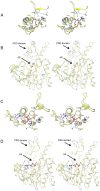Structural characterization of the enzymes composing the arginine deiminase pathway in Mycoplasma penetrans
- PMID: 23082227
- PMCID: PMC3474736
- DOI: 10.1371/journal.pone.0047886
Structural characterization of the enzymes composing the arginine deiminase pathway in Mycoplasma penetrans
Abstract
The metabolism of arginine towards ATP synthesis has been considered a major source of energy for microorganisms such as Mycoplasma penetrans in anaerobic conditions. Additionally, this pathway has also been implicated in pathogenic and virulence mechanism of certain microorganisms, i.e. protection from acidic stress during infection. In this work we present the crystal structures of the three enzymes composing the gene cluster of the arginine deiminase pathway from M. penetrans: arginine deiminase (ADI), ornithine carbamoyltransferase (OTC) and carbamate kinase (CK). The arginine deiminase (ADI) structure has been refined to 2.3 Å resolution in its apo-form, displaying an "open" conformation of the active site of the enzyme in comparison to previous complex structures with substrate intermediates. The active site pocket of ADI is empty, with some of the catalytic and binding residues far from their active positions, suggesting major conformational changes upon substrate binding. Ornithine carbamoyltransferase (OTC) has been refined in two crystal forms at 2.5 Å and 2.6 Å resolution, respectively, both displaying an identical dodecameric structure with a 23-point symmetry. The dodecameric structure of OTC represents the highest level of organization in this protein family and in M.penetrans it is constituted by a novel interface between the four catalytic homotrimers. Carbamate kinase (CK) has been refined to 2.5 Å resolution and its structure is characterized by the presence of two ion sulfates in the active site, one in the carbamoyl phosphate binding site and the other in the β-phosphate ADP binding pocket of the enzyme. The CK structure also shows variations in some of the elements that regulate the catalytic activity of the enzyme. The relatively low number of metabolic pathways and the relevance in human pathogenesis of Mycoplasma penetrans places the arginine deiminase pathway enzymes as potential targets to design specific inhibitors against this human parasite.
Conflict of interest statement
Figures



References
-
- Pollack JD, Williams MV, McElhaney RN (1997) The comparative metabolism of the Mollicutes (Mycoplasmas): the utility for taxonomic classification and the relationship of putative gene annotation and phylogeny to enzymatic function in the smallest free-living cells. Critical Rev Microbiol 23: 269–354. - PubMed
Publication types
MeSH terms
Substances
Associated data
- Actions
- Actions
- Actions
- Actions
LinkOut - more resources
Full Text Sources
Other Literature Sources
Research Materials

